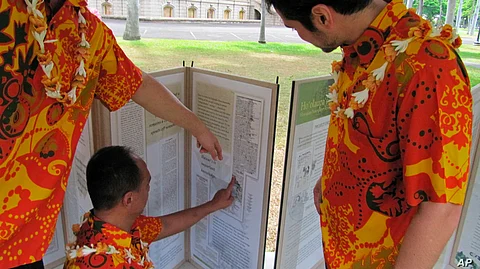
- Home
- न्यूजग्राम
- NewsGram USA
- India
- World
- Politics
- Entertainment
- Culture
- Lifestyle
- Economy
- Sports
- Sp. Coverage
- Misc.
- NewsGram Exclusive
- Jobs / Internships

HONOLULU, HAWAII – Hawaii had a thriving native-language press through the 19th and early 20th centuries, and the language and culture are being revived through a digitizing project at Honolulu's Bishop Museum and an effort to reach modern readers through an online news site.
Since April, Honolulu Civil Beat has been printing a weekly Hawaiian-language section of one or two articles aimed at those who know or are studying the language.
Across town at the Bishop Museum, more than 100 newspapers from a once-thriving Hawaiian language press are being digitized, preserving publications from the 1830s to 1940s.
The museum's collection includes Ka Lama Hawaii, the first newspaper established in Maui in 1834, and the project provides a window on local and world events spanning more than 100 years.
Hawaiian has few remaining native speakers, notes a Honolulu Civil Beat reporter who is a native Hawaiian and has learned the language through studying it in school.
"There are really no words to this feeling of my story being translated into a language for my people that my people are trying to bring back," reporter Ku'u Kauanoe, one of four staff members working on the project, said.
The Hawaiian Islands were unified by King Kamehameha I in 1810 after years of conflict among regional leaders.
The unified nation developed high literacy rates after American missionaries created a written language in the 1820s.
Their descendants, however, overthrew Hawaii's Queen Liliuokalani in 1893, suppressing the language in schools even before Hawaii was annexed as a U.S. territory in 1898. By 1959, when Hawaii became the 50th U.S. state, the Hawaiian language had nearly died out.
In 1993, a century after the overthrow, the U.S. Congress apologized and President Bill Clinton signed the resolution into law.
Hawaiian was revived in the 1970s, becoming the state's second official language, along with English. In the 1980s, immersion schools emerged for students who wanted to improve their fluency.
Hawaii's population is ethnically mixed. In the 19th century, sugar plantations drew workers from Japan, China, the Philippines, Korea and Portugal, and other immigrants have arrived since then, including from other Pacific islands.
"I am Chamorro, which is the Indigenous people of the Mariana Islands," said Civil Beat reporter Anita Hofschneider. Her stories have chronicled the sovereignty movement, which seeks greater self-determination for Hawaiians, and looked at tensions surrounding the Indigenous language.
"I'm very familiar with the history of Indigenous languages being erased and the challenges of bringing them back and helping them flourish," Hofschneider said.
Native speakers of Hawaiian number in the thousands out of a population of 1.4 million in the state, but renewed teaching means that many more now can speak it at a basic level.
Language is tied to land and heritage, said Manuwai Peters, a teacher of Hawaiian who is a reader of the new section of the news site. "The Hawaiian language is almost like the DNA code that has in it our systems of knowledge, our belief system, our history," he said.
Civil Beat operations manager Aja Paet said the language embodies values seen throughout the Pacific islands, "the idea of working with the land and working with the resources you have available."
Honolulu Civil Beat was started in 2010 with funding from eBay founder Pierre Omidyar and his wife, Pam, to cover stories not covered by local media. Today, it's a nonprofit organization that receives donations from readers, foundations and businesses, with Omidyar as publisher, and has become an important news source on the islands.
Some of the stories translated into Hawaiian are on topics of general interest, such as electric vehicles, while some are of special interest to Native Hawaiians, including one on a land dispute with the federal government.
Stories are written in English, then translated with help from experts at the University of Hawaii. Reporters hope to see the project expand.
"That's kind of the dream," said deputy editor Nathan Eagle. "Let's get content coming to us in Hawaiian and then go translate it back." (VOA/RN)
Keywords: Hawaii Language, Newspapers, Press, Revival
